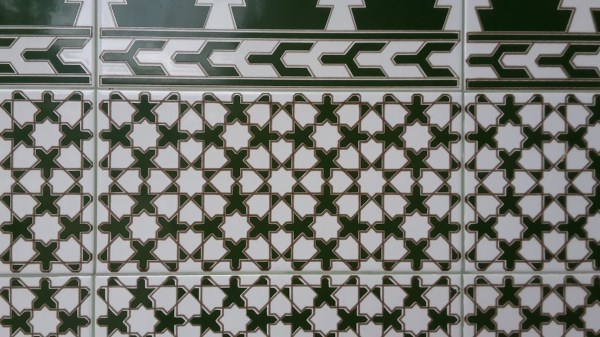Skip over navigation
Take a look at the picture below, showing some tiles at Bayside Boys' School in Gibraltar.

What mathematical questions occur to you?
Here is a close up of a section of the tiled wall.
Does this help you to answer any of your questions?
Does it prompt any new questions?

Becky is approximately 1.7m tall. She is standing by the tiled wall.
Does this help you to answer any of your questions?
Does it prompt any more questions?

Here are some questions we thought of:
What geometric shapes are there in the tiles?
What angles can you work out?
How many squares are there?
How many eight-pointed stars?
Can you recreate a copy of the tile on plain paper?
How big are the tiles?
How many rectangular tiles would you need to tile your classroom?
The tiles are an example of a type of pattern commonly found in Islamic Art.



Or search by topic
Number and algebra
Geometry and measure
Probability and statistics
Working mathematically
Advanced mathematics
For younger learners
Gibraltar Geometry
Age 11 to 14
Challenge Level 





Take a look at the picture below, showing some tiles at Bayside Boys' School in Gibraltar.

What mathematical questions occur to you?
Here is a close up of a section of the tiled wall.
Does this help you to answer any of your questions?
Does it prompt any new questions?

Becky is approximately 1.7m tall. She is standing by the tiled wall.
Does this help you to answer any of your questions?
Does it prompt any more questions?

Here are some questions we thought of:
What geometric shapes are there in the tiles?
What angles can you work out?
How many squares are there?
How many eight-pointed stars?
Can you recreate a copy of the tile on plain paper?
How big are the tiles?
How many rectangular tiles would you need to tile your classroom?
The tiles are an example of a type of pattern commonly found in Islamic Art.
You may also like
Triominoes
A triomino is a flat L shape made from 3 square tiles. A chess board is marked into squares the same size as the tiles and just one square, anywhere on the board, is coloured red. Can you cover the board with trionimoes so that only the square is exposed?
LOGO Challenge 5 - Patch
Using LOGO, can you construct elegant procedures that will draw this family of 'floor coverings'?
LOGO Challenge - Triangles-squares-stars
Can you recreate these designs? What are the basic units? What movement is required between each unit? Some elegant use of procedures will help - variables not essential.

